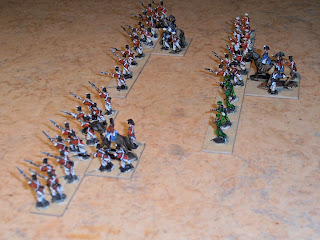The cavalry shako turned out better than expected, so
the Bengal Native troops would have standard peak-less model with brass plate
and tuft, while the Light Dragoons would have the covered shako.
The covered shako, seen in many lithographs of the
period, is secured with a cord to prevent its loss. This simple item proved
more difficult than making the shako plate or tuft. The thin strands of
Milliput kept breaking or slid off the shako. With a good dose of patience,
both tasks were done.
After drying, an
undercoat and paint the final product were varnished. During the First Sikh
War, the covered shakos would be replaced by the covered “soft ” cap with neck
cloth.
Final step is to lay ground (sand and glue) and flock
the bases. The flags will be added tomorrow, so by the weekend I should have
pictures of the completed collection.
cheers,





